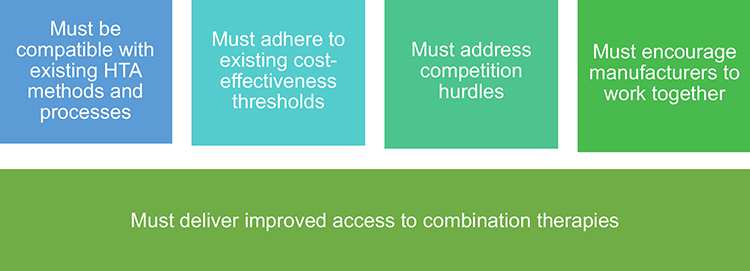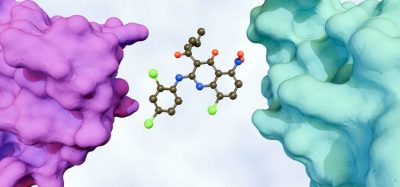Towards a solution for the access challenges faced by combination treatments
Posted: 27 October 2021 | Takeda UK Ltd | No comments yet
In this article, Takeda UK present their Value Attribution and Voluntary Arbitration Frameworks, a potential solution for the combination treatment challenge.


COMBINATION treatments can result in improved outcomes for patients; however, they may present a cost effectiveness challenge, especially when multiple on-patent treatments are combined. Combination treatments often include a novel ‘add-on’ therapy coupled with a ‘backbone’ treatment and can face difficulty navigating the health technology assessment (HTA) process and attaining reimbursement especially in cost-effective markets. This article looks at the problems identified and explores a potential solution for the pharmaceutical industry and broader healthcare community to consider and work together to deliver.
In 2014, a National Institute for Health and Care Excellence (NICE) Decision Support Unit (DSU) report by Davis S, et al outlined the circumstances in which medicines that are clinically effective may not be deemed cost‑effective, even at zero price. They highlighted that, in some situations, a combination treatment consisting of a backbone treatment and a novel add-on treatment may fail to be cost-effective even if the price of the add-on treatment is zero and given away for free.
The main challenge is that combination treatments are evaluated as single technologies but contain multiple components that are priced independently. One of the key issues here is that combination treatments often extend disease-free or progression-free survival, which in turn extends the duration of treatment. This extended duration increases the cost associated with the backbone treatment, which alone can exceed the “Willingness-To-Pay” (WTP) threshold – a term economists use to determine the maximum allowance a healthcare system is willing to pay per health gain. This means the add-on component of a combination treatment has a more reduced opportunity to demonstrate value. This issue is made even more complicated if each component treatment in a combination is made by different pharmaceutical manufacturers, as companies cannot discuss and align on pricing because it is strictly prohibited by competition law.
There is consensus within key stakeholder groups, nationally and internationally, that solutions for accessing combination treatments need to be found quickly for the benefit of patient outcomes, now and in the future.
In 2019, an Australian research ethics organisation, the Bellberry Group, convened an international group of HTA experts and representatives of HTA bodies to discuss the challenges associated with valuing and paying for combination treatments, specifically in oncology. Their report further established the problem and identified further work to inform potential solutions. There have since been numerous presentations on this topic at health economic conferences and several stakeholder groups across Europe have started work on this issue.
To contribute a potential solution for the combination treatment challenge, Takeda UK Ltd held a parliamentary roundtable in 2016 and, in 2019, established an expert Advisory Group with whom they collaborated to design a proposed transactable and implementable solution. This solution, detailed within two whitepapers, is discussed in this article for wider review and consideration. The proposed solution was developed using the UK and NICE as an archetype; however, the authors believe that the solution can be adapted for other markets.
Acknowledgement
This article has been developed and funded by Takeda UK Ltd.
How should the value of a combination treatment be apportioned between component treatments? The proposed Value Attribution Framework
By Professor Andrew H Briggs, Professor of Health Economics at the London School of Hygiene & Tropical Medicine
AS A HEALTH economist, I have long been aware of the increased use of combination treatments in modern medical practice and the cost-effectiveness complexities this generates for health technology assessments. This is a very pressing issue for the global pharmaceutical industry and is likely to impact many biotech and pharmaceutical companies, the healthcare professionals you support and ultimately the patients you serve. Yet, you may be able to participate in a solution – here is how and why.
The Value Attribution Framework is proposed as the starting point for negotiations”
In this article, I will attempt to answer the question, ‘how should the value of the combination treatment be apportioned between component treatments?’ This is an important first step that myself, Takeda and colleagues have tried to address in the whitepaper “An Attribution of Value Framework for Combination Therapies”. This framework is meant to serve as a preliminary structure to facilitate discussion, among interested and affected stakeholders, surrounding the challenge of demonstrating cost-effectiveness when multiple on-patent treatments are combined in a therapeutic regimen.
The Value Attribution Framework is proposed as the starting point for negotiations which are detailed within the Voluntary Arbitration whitepaper; also covered in this article.
It has long been known that combination treatments may exhibit greater clinical efficacy than a single treatment when their component treatments have complementary pharmacodynamic effects. This discussion will be relevant to combination treatments in many fields, but the focus of our discussion was oncology. In many markets, to achieve access, combination treatments must be priced with their value measured by a WTP threshold per health gain. In cost‑effectiveness markets, health gain is measured using a standard metric called the Quality Adjusted Life Year (QALY). In the UK the upper end of NICE’s standard WTP threshold for a QALY is currently £30,000; this threshold was considered within the Value Attribution Framework and has been applied to the four main scenarios detailed below. Although the framework has focused on NICE’s methods and processes, it is designed to be replicated in other market archetypes.
To address the question of how the reimbursement price of the combination product should be shared across the component treatments, we must determine how much value should be attributed to each of the components. The standard rules of cost-effectiveness analysis are outlined in the framework and use of the QALY metric, combined with the WTP threshold, means that it is independent of the prices set for the individual component treatments.
The proposed framework is explored through four scenarios which are characterised by key features of the problem outlined here:
- Perfect information and balance of power: this scenario and solution starts with a very simple case; we assume that the same manufacturer makes all components of a combination and is therefore motivated to price optimally for the combination
- Perfect information and imbalance of market power: the solution presented for this scenario accounts for observed preferences in the clinical effectiveness of each of the component treatments
- Imperfect information and balance of market power: the scenario explores when the benefits of a backbone treatment are known, but the benefit of the add-on treatment as a monotherapy is not known or cannot be measured. In this solution we assume the combination is additive.
- Imperfect information and imbalance of power: this scenario explores the situation where component treatments are owned by different manufacturers. This is the most likely ‘real-world scenario’ and is the most challenging of the situations. The solution allows the articulation of a negotiable share of incremental value attributed to each of the component treatments.
The Value Attribution Whitepaper demonstrates how the framework can be applied through case studies of combination treatments that have been previously appraised by NICE; each chosen to illustrate the four different scenarios.


C-ANPROM/EUC/OG/0007
Date of preparation: October 2021
For further information, visit: www.takeda.com/en-gb/what-wedo/combination-treatments
Overcoming the combination treatment challenge; Takeda’s proposed Voluntary Arbitration Framework
By Tanja Podkonjak, Director of EUCAN Oncology Access and Reimbursement Policy
AT TAKEDA UK LTD, we are guided by our commitment to put patients at the forefront of everything we do. This has driven our determination to collaborate with key stakeholders to find solutions to complex challenges, including that of access to combination treatments.
In collaboration with experts from the economic, law, academic, clinical and patient communities, Takeda has worked to co-develop two whitepapers, which set out a proposed solution for improving access to combination treatments. We took a collaborative approach because we felt it was important the proposed solution was transactable and could meet the needs of all key stakeholders. To achieve this, we also sought input from experts from NHS England and NICE on the key challenges.
We believe our solution is the first to propose comprehensive frameworks covering both an economic value attribution methodology – Value Attribution Framework – and a standard operating procedure to support compliant dialogue between pharmaceutical companies – Voluntary Arbitration Framework. The solution is treatment and disease agnostic and has been designed to align with current NICE appraisal processes and NHS England commercial methods, but we believe the principles could be applied to other countries as well.
The combination treatment challenge is a complex problem with multiple existing requirements, processes and frameworks to consider. Therefore, to develop a transactable framework, we started with the key requirements (shown in Figure 1) and developed a solution from the ground up.


Figure 1: Requirements for a transactable framework
Building from the requirements shown in Figure 1, the Voluntary Arbitration Framework introduces new elements that work to address each of these requirements.
To address concerns around inter-company dialogue on sensitive topics of pricing and reimbursement, and to address competition law hurdles, the Voluntary Arbitration Framework proposes the use of ‘clean teams’. Clean teams are a construct used in merger and acquisition transactions to manage sharing of sensitive information between businesses. Setting up clean teams would ring-fence the information divulged during the Value Attribution Framework and avoid the dissemination of sensitive data to the wider businesses.
The Voluntary Arbitration Framework envisages the appointment of an independent arbitrator to facilitate the discussion between clean teams. The arbitrator will have an important role to play in overseeing the arbitration; using their expertise to help facilitate discussions between manufacturer clean teams and, in case of an impasse, offer a recommended value attribution for the combination treatment.
Due to the unique challenge presented by combination treatments, we would argue that the solution will require the ability to utilise non-uniform pricing for the component treatments. This would be important to reassure the backbone manufacturer that any deal reached for the combination would not impact the rest of their business and is also vital in not breaching competition law. Without uniform pricing, a negotiated deal for the components of a combination would also impact the price of the components when they are used as monotherapies and in potential competition. Non-uniform pricing would therefore enable a bespoke arrangement that only applies to the combination and would address this competition law hurdle.
Another important aspect of the framework will be the proposal to have a long-term commitment from all manufacturers to partake in the arbitration process. With most manufacturers having combination treatments in their pipeline – in some instances you may own the add‑on treatment, but in others, you may own the backbone – we believe there is benefit to all to have a process that industry has signed up to. Under this proposal, manufacturers would commit to participate in the process in good faith but reserve the right to withdraw from the arbitration at any point should a deal not be deemed possible.
Conclusion and next steps
The proposed solution presented in the two whitepapers was intended to serve as a starting point for a discussion from which we hope to generate dialogue, to get feedback and to stimulate further thinking, as well as ultimately help to define a solution which can be adopted by all stakeholders and in all market archetypes. We are aware of other groups who are also working to develop solutions for the combination treatment challenge. We welcome all work on this complex issue and believe that every proposed solution adds to the discussion and will bring the community closer to ultimately solving this important issue.
We gratefully acknowledge the kind assistance of our co-authors, the advisory group members and independent experts for their input. This might not be a perfect solution yet, but with some debate, intellectual vigour and tenacity, we are confident we will get there. Together, as a wider healthcare community, we genuinely hope that we can make a breakthrough to help ensure that novel combination treatments get to the patients that need and could benefit from them as rapidly as possible.


C-ANPROM/EUC/OG/0007
Date of preparation: October 2021
Issue
Related topics
Drug Development, Drug Markets, Funding, Industry Insight, Regulation & Legislation, Therapeutics
Related organisations
Bellberry Group, UK National Institute for Health and Care Excellence (NICE)









